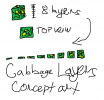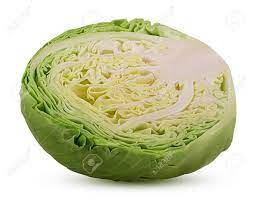Request: Cabbage Layers
Request Type: General Addition
Try to describe all workarounds and associated issues that make it necessary to add this block in your eyes.
I think adding Cabbage layers is necessary to ensure that all our cabbage fields feel nice and smooth, especially those that are on an uneven ground, I would like to compare this addition to that of pebble layers that got added a while back. As it would be used in a similar way - to make the landscape feel more smooth and natural. The river pebbles greatly help us when creating beaches and riverbanks giving them a nice smooth transition between height differences and an alternative to muddy riverbanks. Same could be said for cabbage layer addition, as it would give us an option for smoother cabbage fields that would be layered based on its shape and terrain, greatly enhancing their looks and the quality of the entire build!
Furthermore It could be used to substitute for a certain blocks such as patterned green carpet, or it could be used to represent a chopped up cabbage!

Thank you for your consideration,
_Simbaa
Types of evidence to support your request: Historical, Canon
Historical Evidence
Cabbage as we know it has evolved into a vegetable with a leafy head made up of many layers of leaves.

Canonical Evidence
There are certainly quite a few quotes that could suggest cabbage layers are a thing in Westeros such as:
File(s) attached
Request Type: General Addition
Try to describe all workarounds and associated issues that make it necessary to add this block in your eyes.
I think adding Cabbage layers is necessary to ensure that all our cabbage fields feel nice and smooth, especially those that are on an uneven ground, I would like to compare this addition to that of pebble layers that got added a while back. As it would be used in a similar way - to make the landscape feel more smooth and natural. The river pebbles greatly help us when creating beaches and riverbanks giving them a nice smooth transition between height differences and an alternative to muddy riverbanks. Same could be said for cabbage layer addition, as it would give us an option for smoother cabbage fields that would be layered based on its shape and terrain, greatly enhancing their looks and the quality of the entire build!
Furthermore It could be used to substitute for a certain blocks such as patterned green carpet, or it could be used to represent a chopped up cabbage!

Thank you for your consideration,
_Simbaa
Types of evidence to support your request: Historical, Canon
Historical Evidence
Cabbage as we know it has evolved into a vegetable with a leafy head made up of many layers of leaves.
Canonical Evidence
There are certainly quite a few quotes that could suggest cabbage layers are a thing in Westeros such as:
....cabbage leaf, then.
...that might have been some queer sort of cabbage
To delve deeper into the meaning of the first quote, which I believe is the prime example of evidence supporting my block request - A cabbage as we all know is biennial plant grown as an annual vegetable crop for its dense-leaved heads, which obviously consist of many different and unique layers of leaves, which should definitely be represented in the block more, the suggestion of a "cabbage leaf" thus suggests that the cabbages of Westeros do infact have layers....rows of cabbages
File(s) attached




















